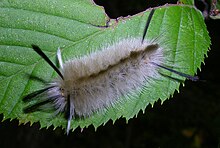| Halysidota tessellaris | |
|---|---|

| |
| Conservation status | |
 Secure (NatureServe) | |
| Scientific classification | |
| Domain: | Eukaryota |
| Kingdom: | Animalia |
| Phylum: | Arthropoda |
| Class: | Insecta |
| Order: | Lepidoptera |
| Superfamily: | Noctuoidea |
| Family: | Erebidae |
| Subfamily: | Arctiinae |
| Genus: | Halysidota |
| Species: | H. tessellaris |
| Binomial name | |
| Halysidota tessellaris (J. E. Smith, 1797) | |
| Synonyms | |
| |

Halysidota tessellaris, also called the pale tiger moth, banded tussock moth, and tessellated halisidota, is in the family Erebidae and the tribe Arctiini, the tiger moths. The species was first described by James Edward Smith in 1797. Like many related species, adult moths have chemical defenses acquired from its host plants, in this case, alkaloids. Larval behaviors suggest that they are chemically protected; they have not been analyzed for alkaloid content.
Range
This moth is found in North America from southern Canada south through Texas and central Florida.
Life cycle
One generation per year occurs in the north, and two or more occur in the south.
Egg
Eggs are laid in masses on the undersides of leaves.

Larva
Caterpillars are covered with long setae, in tufts. They vary from yellowish and orange through dark gray. Extra long hair-pencils of white, black, and/or orange occur at both the front and rear of a caterpillar. Larval head capsules are bright orange. In the north, mature caterpillars are found from July to frost. Caterpillars frequently rest on the upper surface of leaves, and though not gregarious, they are very conspicuous. They grow to a length of up to 1.75 inches (44 mm). The hairs are urticating and easily dispersed by the caterpillar.
Pupa
Pupae overwinter in gray cocoons laced with larval hairs.
Adults
Wings are light brown. Forewings have bands of beige edged in black. The body is 'hairy' and yellow. The thorax has blue-green lines on its uppersides. Adults are attracted to decaying plants with pyrrolizidine alkaloids. They regurgitate on them, then drink the fluids, and acquire defensive chemicals.

The moth appears very similar to the sycamore tussock moth (Halysidota harrisii) in the adult stage and may be distinguished based on differences in genitalia.
Food plants
Larvae are known to feed on some species of alder, ash, birch, blueberry, chestnut, elm, grape, hackberry, hazel, oak, walnut, willow, and many others. No serious injury to trees has been reported for this late-season feeder.
References
- Hodges, R.W (1983). "Halysidota tessellaris - (J.E. Smith, 1797) Banded Tussock Moth". NatureServe. Retrieved 17 September 2019.
- Hristov, Nickolay; Conner, William E. (2005). "Effectiveness of tiger moth (Lepidoptera, Arctiidae) chemical defenses against an insectivorous bat (Eptesicus fuscus)". Chemoecology. 15 (2): 105–113. doi:10.1007/s00049-005-0301-0. ISSN 0937-7409. S2CID 33676051.
- WELLER, SUSAN J.; JACOBSON, NANCY L.; CONNER, WILLIAM E. (1999). "The evolution of chemical defences and mating systems in tiger moths (Lepidoptera: Arctiidae)". Biological Journal of the Linnean Society. 68 (4): 557–578. doi:10.1111/j.1095-8312.1999.tb01188.x. ISSN 0024-4066.
- ^ Wagner, David L. (2010-12-31). Caterpillars of Eastern North America. Princeton: Princeton University Press. doi:10.1515/9781400834143. ISBN 978-1-4008-3414-3.
- ^ Rose, A. H. (Arthur H.) (1982). Insects of eastern hardwood trees. Lindquist, O. H. Ottawa: Department of the Environment, Canadian Forestry Service. ISBN 0-660-11205-1. OCLC 10305246.
- "banded tussock moth (Halysidota tessellaris)". MinnesotaSeasons.com. 11 August 2024 . Retrieved 25 September 2024.
- ^ "Field Guide: Banded Tussock Moth". Missouri Department of Conservation. Conservation Commission of Missouri. Retrieved 25 September 2024.
- Krasnoff, Stuart B.; Dussourd, David E. (1989). "Dihydropyrrolizine attractants for arctiid moths that visit plants containing pyrrolizidine alkaloids". Journal of Chemical Ecology. 15 (1): 47–60. doi:10.1007/bf02027773. ISSN 0098-0331. PMID 24271426. S2CID 12407539.
External links
- "Halysidota tessellaris". Moths of Maryland.
- Bartlett, Troy (September 2, 2019). "Species Halysidota tessellaris - Banded Tussock Moth - Hodges#8203". BugGuide. Retrieved September 17, 2019.
| Taxon identifiers | |
|---|---|
| Halysidota tessellaris | |